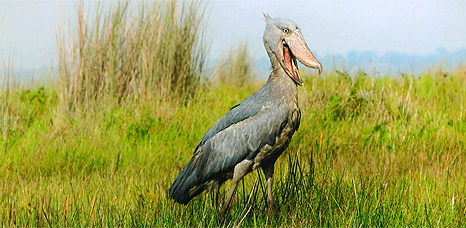Alan Dale Hands travelled on our 'Uganda - Shoebills to Gorillas' tour and submitted this entry to our writing competition.
Shoebill by Alan Dale Hands
Two wooden canoes powered by small outboard motors were manoeuvred skilfully by the boatmen through the narrow channels running through the Papyrus reeds. Malachite Kingfishers, disturbed by our presence and flying close, accompanied by a few small Dragonflies, were the only wild life of interest that could be seen, as the Papyrus was so tall and dense.
However, as the channel widened a little, a more open area appeared on one side. The engines were cut and the boatman heard to whisper ‘SHOEBILL’. Now, with an almost total silence (as breathing seemed to cease), the massive head of this huge stork-like bird showed above some shorter vegetation. Moving to an area of lily-covered water, very slowly and gracefully for such a large and heavy-looking bird with a bill the size and shape of a large clog, enabled our group to view a bird which would not have looked out of place in Jurassic Park. Hunting, with majestic movements, each foot hardly causing a ripple, one had to marvel at the grace with which the Shoebill moved. Then came a surprise. With a speed that defied its bulk our bird plucked a hapless meal from the water. This feeding action being so swift, the prey could not be identified.
Time stood still and cameras were clicking frantically; there must have been hundreds of pictures taken. Eventually, the two or three flighty Long-toed Lapwings were noted, also a Blue-breasted Bee-eater showed well; however, a skulking Lesser Jacana required much patience to obtain reasonable views.
Returning through open water, Papyrus Gonolek provided interest, and by the time we were back on dry land our group was stunned when realising that we had only been in Uganda for 12 hours.
Another boat ride the next day on Lake Mburo provided excellent views of such hard species as White-backed Night Heron, African Finfoot and the very difficult to view White-winged Warbler. Also many snorting Hippopotamuses and a couple of very large basking Nile Crocodile all made for a very enjoyable cruise. Back on terra firma, the Mburo National Park gave great views of more birds, including the much-loved Long-crested eagle, a species believed to feed on rats and mice. However, for the writer, the tame Common Warthog moving about the park reception area in the close proximity of people, three of them sleeping beneath a tree near a reception door, made for another memorable episode.
A brief stop at the Kalinzu Forest Reserve during the journey to Queen Elizabeth National Park turned up cracking views of Petit’s Cuckoo Shrike; the female performed particularly well, and both birds were seen at the nest. This site also turned up a single Black Bee-eater, another much sought-after species. Arrival at Queen Elizabeth National Park soon brought success, with a troop of Guereza Colobus monkeys entertaining.
A male Lion ambling along the road near Mweya Lodge, Queen Elizabeth National Park , I am sure knew of our presence but chose to ignore us. The nearby Kazinga Channel provided the last boat trip of our Ugandan venture and once again the wildlife provided excellent viewing. Two Elephant grappling in the water, many more Hippos, hundreds of African Skimmers and several species of heron, stork and waders were a joy to see.
Kibale Forest not only provided a change in bird species seen, beautiful bush shrikes, sunbirds etc., but proved to hold attractive monkey species like Grey-cheeked Mangabey and Re-tailed Mangabey.
This tour, led by a brilliant leader, had everything for anyone who enjoys viewing wildlife.
Read more Gorilla watching in Uganda about our 'Uganda - Shoebills to Gorillas' holiday.



 Loading search...
Loading search...
